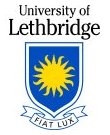Math 1410, Spring 2020
Introduction to Vectors
January 9, 2020
| Sean Fitzpatrick |
|---|
| University of Lethbridge |
 |
Cartesian coordinates
We will work mainly in two and three dimensions. We write:
\(\R^2 = \{(x,y) \,|\, x,y\in \R\}\) — set of all points in the plane
\(\R^3 = \{(x,y,z) \,|\, x,y,z\in \R\}\) — set of all points in “space”
Can define \(\R^4, \R^5\text{,}\) etc. similarly, but can't draw them.
Distance comes from the Pythagorean theorem. In \(\R^2\text{,}\) the distance from \((x_1,y_1)\) to \((x_2,y_2)\) is
Vectors
A vector is a “directed line segment”. It has magnitude and direction.
The position of a vector usually doesn't matter.
Given points \(P\) and \(Q\) we write \(\vec{v}=\overrightarrow{PQ}\) for the vector from \(P\) to \(Q\text{.}\) (Tail at \(P\text{,}\) tip at \(Q\text{.}\))
The magnitude of \(\vec{v}\) is just the distance from tip to tail. We write \(\norm{\vec{v}}\) for the magnitude of \(\vec{v}\text{.}\)
Vector notation
We can't do much by just drawing arrows. Let \(P=(x_1,y_1), Q=(x_2,y_2)\) be two points in the plane.
We write \(\vec{v}=\overrightarrow{PQ}\) in component form as \(\vec{v}=\langle x_2-x_1, y_2-y_1\rangle\text{.}\)
Equivalent notation is the column vector \(\vec{v}=\bbm x_2-x_1\\y_2-y_1\ebm\text{.}\)
Magnitude becomes \(\norm{\vec{v}}=\sqrt{(x_2-x_1)^2+(y_2-y_1)^2}\text{.}\)
Examples
Let \(P=(1,2)\) and \(Q=(3,-4)\text{.}\) Find:
\(\overrightarrow{PQ}\)
\(\orr{QP}\)
\(\norm{\orr{PQ}}\)
Exercise: Repeat the above for \(P=(1,-2,4)\) and \(Q=(3,0,-2)\text{.}\)
Exercise: If \(\orr{PQ}=\la 3,-1,5\ra\) and \(Q=(2,2,-3)\text{,}\) what is \(P\text{?}\)
Contexts
Vectors appear frequently in Physics:
Displacement
Velocity
Force
etc.
Can think in terms of simple directions: \(\vec{v}=\la 3,4\ra\) tells us to go 3 units right, 4 units up.
Also find vectors as data arrays (but no longer geometric). Meaning of “vector” expands in second linear algebra course.
Adding vectors
To add vectors, we simply add components.
In \(\R^2\text{,}\) with \(\vec{v}=\la v_1,v_2\ra, \vec{w}=\la w_1,w_2\ra\text{,}\)
\begin{equation*} \vec{v}+\vec{w}=\la v_1+w_1,v_2+w_2\ra\text{.} \end{equation*}In \(\R^3\text{,}\) with \(\vec{v}=\la v_1,v_2,v_3\ra, \vec{w}=\la w_1,w_2,w_3\ra\text{,}\)
\begin{equation*} \vec{v}+\vec{w}=\la v_1+w_1,v_2+w_2,v_3+w_3\ra\text{.} \end{equation*}
Exercise:
Ask me for examples.
Find \(\la 2,4\ra+\la -5,1\ra\text{.}\)
Find \(\la 4,-2,1\ra - \la 3,-7,6\ra\text{.}\) (How do you think we should define subtraction?)
If \(\vec{x}+\la 3,2\ra = \la 5,9\ra\text{,}\) what is \(\vec{x}\text{?}\)
Addition, geometrically
As “arrows”, vector addition follows “tip-to-tail rule”:
Draw \(\vec{v}\text{.}\)
Draw \(\vec{w}\) with its tail at the tip of \(\vec{v}\text{.}\)
-
Draw an arrow from the tail of \(\vec{v}\) to the tip of \(\vec{w}\text{.}\)
This is \(\vec{v}+\vec{w}\text{.}\)
Exercise: try this, for \(\vec{v}=\la 2,1\ra\) and \(\vec{w}=\la 3,2\ra\text{.}\)
Exercise: for \(P=(1,0), Q=(2,2), R=(4,5)\text{,}\) compute \(\orr{PQ},\orr{QR},\orr{PR}\text{,}\) and \(\orr{PQ}+\orr{QR}\text{.}\)
Challenge: show why this works in general, for \(P=(x_1,y_1), Q=(x_2,y_2), R=(x_3,y_3)\text{.}\)
Scalar multiplication
-
Exercise: if \(\vec{v}=\la 3,2,4\ra\text{,}\) what is \(\vec{v}+\vec{v}\text{?}\)
How are the components related to those of \(\vec{v}\text{?}\)
-
We don't have a good way to define multiplication of two vectors. But we can multiply a vector by a number. This is called scalar multiplication.
Given a real number \(c\) and a vector \(\vec{v}=\la a,b\ra\text{,}\)
\begin{equation*} c\vec{v} = c\la a,b\ra = \la ca,cb\ra\text{.} \end{equation*}The story in \(\R^3\) is similar:\begin{equation*} c\la x,y,z\ra = \la cx,cy,cz\ra\text{.} \end{equation*}
Scalar multiplication, geometrically
\(2\vec{v}=\vec{v}+\vec{v}\text{,}\) so \(2\vec{v}\) is in the same direction as \(\vec{v}\text{,}\) but twice as long.
What does \(-2\vec{v}\) give us?
In general, we have:
Theorem:
For any vector \(\vec{v}\) and scalar (number) \(c\text{,}\)
\begin{equation*} \norm{c\vec{v}}=\lvert c\rvert \norm{\vec{v}}\text{.} \end{equation*}
Parallel vectors, unit vectors
Definition: Parallel vectors.
We say that two vectors \(\vec{v}\) and \(\vec{w}\) are parallel if \(\vec{w}=c\vec{v}\) for some scalar \(c\text{.}\)
Definition: Unit vector.
A vector \(\vec{u}\) is a unit vector if \(\norm{\vec{u}}=1\text{.}\)
Unit vectors are useful when we care about direction, but not magnitude.
Given \(\vec{v}=\la 2,3\ra\text{,}\) what is a unit vector in the direction of \(\vec{v}\text{?}\)
Standard unit vectors
In \(\R^2\text{:}\)
In \(\R^3\text{:}\)
Properties of vector algebra
Whoa, we have time for this?